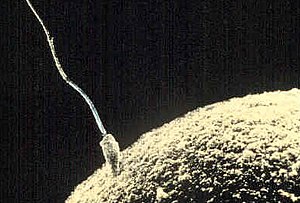| Spermatozoon | |
|---|---|
 | |
 Diagram of a human spermatozoon | |
| Details | |
| Identifiers | |
| Latin | spermatozoon |
| Greek | σπερματοζωάριο |
| MeSH | D013094 |
| Anatomical terms of microanatomy | |
A spermatozoon (/spərˌmætəˈzoʊ.ən, ˌspɜːrmətə-/;[1] also spelled spermatozoön; pl.: spermatozoa; from Ancient Greek σπέρμα (spérma) 'seed' and ζῷον (zôion) 'animal') is a motile sperm cell produced by male animals relying on internal fertilization. A spermatozoon is a moving form of the haploid cell that is the male gamete that joins with an ovum to form a zygote. (A zygote is a single cell, with a complete set of chromosomes, that normally develops into an embryo.)
Sperm cells contribute approximately half of the nuclear genetic information to the diploid offspring (excluding, in most cases, mitochondrial DNA). In mammals, the sex of the offspring is determined by the sperm cell: a spermatozoon bearing an X chromosome will lead to a female (XX) offspring, while one bearing a Y chromosome will lead to a male (XY) offspring. Sperm cells were first observed in Antonie van Leeuwenhoek's laboratory in 1677.[2]
- ^ "spermatozoon". Dictionary.com Unabridged (Online). n.d.
- ^ "Timeline: Assisted reproduction and birth control". CBC News. Archived from the original on 2016-04-28. Retrieved 2006-04-06.